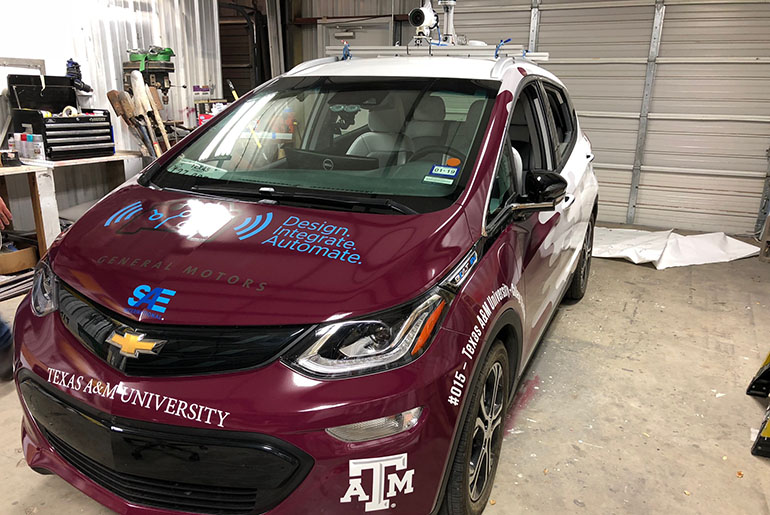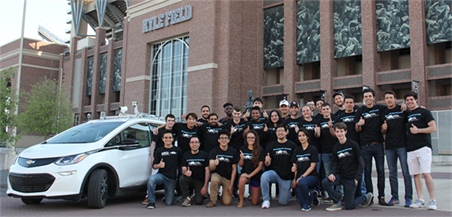
By Jennifer Reiley, Rachel Rose and Chris Scoggins
Eight teams from universities across North America will gather April 30 to May 5 at Yuma, Arizona, for the Society of Automotive Engineers (SAE) AutoDrive challenge, a three-year competition that allows university teams to develop and demonstrate their own autonomous vehicle.
The competition is broken down into segments of yearly benchmarks, with the goal of having a vehicle that can navigate an urban driving course autonomously while adhering to specific conditions and requirements identified by the SAE.
When General Motors (GM) and SAE International announced last year that Texas A&M University was one of the eight North American universities selected to compete in the three-year challenge, the team was supplied with a Chevy Bolt, and has been working for the past year to prepare the vehicle and themselves for the upcoming benchmark showcase.
 Civil engineering doctoral students Yang Woo Kim and Gihyeob An, computer science senior Steven Leal and mechanical engineering senior Brianne Murray have worked alongside more than 40 students from six departments within the Texas A&M College of Engineering to get the car ready for the spring 2018 competition.
Civil engineering doctoral students Yang Woo Kim and Gihyeob An, computer science senior Steven Leal and mechanical engineering senior Brianne Murray have worked alongside more than 40 students from six departments within the Texas A&M College of Engineering to get the car ready for the spring 2018 competition.
“I’ve always had an interest in autonomous vehicles,” Kim said. “I have a background in image processing and computer coding and have worked in the electronics industry previously, so I was excited to get the opportunity to work on this project.”
The Aggie team was split into 10 sub teams, each assigned with a different task for the overall project. Kim and Leal work with the lane detection team, coding the car with the ability to detect lanes and other objects from its bird’s eye view camera. An’s work involves getting the car from one point to another, creating a waypoint for the vehicle to follow as it moves from destination to destination while following a trajectory.
As they’ve completed their tasks the team members have branched out to other groups within the overall team, helping with heat exchange and design. Murray started as part of the longitudinal control team, developing code and mechanics to help the car move forward and brake. Before assisting the lane detection team, Leal was assigned to the simulation team, creating a simulated vehicle that the team could use to virtually test their ideas for the actual car.
“We had a lot of people with the technical know-how to create control algorithms because they have taken these classes and they could whip them up in MatLab and show a really nice graph, but we needed to implement it into an environment that could work specifically on our server hardware that was running inside of the vehicle,” Leal said. “That transition required someone with the technical know-how between different programming languages.”
“I think for any senior design project you’re never really prepared, and you learn most while you’re in the project trying to collect data and scope,” Murray said.
Throughout the last two semesters, Murray said she has gained new skills in communication and project management and overall it has been a valuable experience.
“We’re trying to figure out where we fit in on the scope of things, how big is our project on the scale of things and how can we be leaders and encourage each other while also being present with the bigger group,” she said.
Leal said that the project brought many challenges to the team.
“It’s surprising at the end of this that each individual part of the project, such as object detection, seems simple enough, however communicating each set of data to a waypoint planner and then having the waypoint planner correctly send data over to the control teams it starts to become a really complex problem,” Leal said.
In Arizona, the car will be hooked up to GM’s testing hardware so they can record data as they perform goals within the test. Once the team gets on site there will be three tests performed. First, the car will have to pass a straight line test where it will go down a single lane and stop each time it approaches a stop sign. The second test will be the lateral challenge where the car has to navigate through a curvy, one lane road and stop at the end. The final test is the object detection, or lane change, challenge.
The students look forward to the competition as not only a way to showcase their skills, but as a way to identify areas for the vehicle’s improvement and development.
“I think this competition is a good opportunity for students to run actual skills,” An said. “Challenges like this are what help students apply their knowledge and gain practical understanding, and I am glad to be a part of it.”
All students have been led and supported by faculty members across the Texas A&M College of Engineering, including:
Zachry Department of Civil Engineering:
Dr. Alireza Talebpour – associate professor and project leader
Department of Computer Science and Engineering:
Dr. Dezhen Song – professor
Department of Electrical and Computer Engineering:
Dr. Peng Li - professor
Department of Mechanical Engineering:
Dr. Debiyoti Banerjee - professor
Dr. Swaroop Darbha - professor
Dr. Swaminathan Gopalswamy - professor of practice
Dr. Sivakumar Rathinam - associate professor